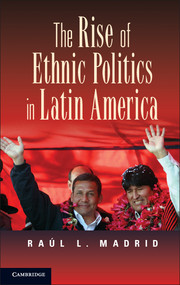Book contents
- Frontmatter
- Contents
- Figures
- Tables
- Acknowledgments
- Abbreviations
- 1 Ethnicity and Ethnopopulism in Latin America
- 2 The Ascent of the MAS in Bolivia
- 3 The Rise and Decline of Pachakutik in Ecuador
- 4 Ethnopopulism without Indigenous Parties in Peru
- 5 Indigenous Parties outside of the Central Andes
- 6 Indigenous Parties and Democracy in the Andes
- 7 Conclusion
- Bibliography
- Index
7 - Conclusion
Published online by Cambridge University Press: 05 December 2012
- Frontmatter
- Contents
- Figures
- Tables
- Acknowledgments
- Abbreviations
- 1 Ethnicity and Ethnopopulism in Latin America
- 2 The Ascent of the MAS in Bolivia
- 3 The Rise and Decline of Pachakutik in Ecuador
- 4 Ethnopopulism without Indigenous Parties in Peru
- 5 Indigenous Parties outside of the Central Andes
- 6 Indigenous Parties and Democracy in the Andes
- 7 Conclusion
- Bibliography
- Index
Summary
Although ethnic parties are commonplace in much of the world, there is still little consensus on what leads them to emerge and thrive. Scholars have proposed theories that focus on a wide range of explanatory variables, from institutional factors to primordial ties. These theories shed much light on the recent emergence of indigenous parties in Latin America, but they cannot explain why some of these parties have fared well while others have performed poorly. Nor can they explain why some indigenous parties in the region were able to win support across ethnic lines.
This study has argued that the successful indigenous parties in Latin America have won by combining inclusive ethnic and populist appeals. They have wooed indigenous voters by recruiting indigenous candidates, maintaining strong ties with indigenous organizations, invoking indigenous symbols, and adopting traditional indigenous demands. These appeals have worked particularly well where the indigenous population is relatively large, well-organized, and ethnically conscious.
- Type
- Chapter
- Information
- The Rise of Ethnic Politics in Latin America , pp. 185 - 194Publisher: Cambridge University PressPrint publication year: 2012

